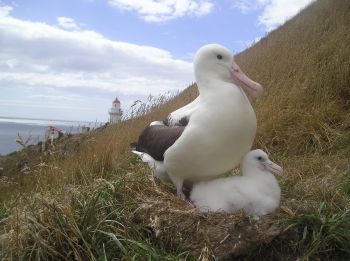New Zealand's Marine Conservation Services Annual Plan published on-line this month includes services to be delivered that are subject to cost recovery from the commercial fishing industry. The Conservation Services Programme's objectives are to understand the nature and extent of adverse effects from commercial fishing activities on protected species in New Zealand fisheries waters and to develop effective solutions to mitigate these adverse effects.
One such ‘service' for 2011/12 is to update estimates of key population parameters using existing information for the Northern Royal Albatross Diomedea sanfordi.
The internationally Endangered Northern Royal Albatross is classified as "Naturally Uncommon" within New Zealand, and breeds primarily at the Chatham Islands, with a small population at Taiaroa Head on the Otago Peninsula, South Island. This mainland locality supports one of the very few albatross breeding colonies which can be easily viewed by the public.
The species has been observed captured in offshore trawl and surface longline fisheries and recent quantitative risk assessment work has found considerable potential risk from a range of trawl and longline commercial fisheries. Sensitivity analysis performed as part of this risk assessment found much of the uncertainty around estimated risk came from uncertainty around estimates of adult survival and number of breeding pairs.
Whereas detailed information from the main breeding colonies is generally poor, the Taiaroa Head colony has been intensively monitored over many years and the potential exists for further analysis of these data to update and improve estimates of adult survival and other population dynamics relevant to assessing susceptibility of the species to human-induced impacts.
A technical report or reports describing the methods used and estimates derived for key population parameters of the Northern Royal Albatrosses of the Taiaroa Head colony will be the outcome of the project.

Other activities to address fisheries-induced seabird mortality outlined in the 2011/12 Annual Plan include:
Identification of seabirds captured in New Zealand fisheries;
Undertaking a population study trial and investigating at-sea distribution of the Flesh-footed Shearwater Puffinus carneipes;
Mitigating seabird captures from New Zealand Scampi Metanephrops challengeri trawls;
Developing strategies to increase line sink rates and novel methods to reduce availability of hooks to seabirds in inshore bottom longline fisheries;
Producing a bimonthly Protected Species Bycatch Newsletter addressed to trawl and longline fishers;
Protected species mitigation training for commercial fishing vessel crews; and
Reviewing mandatory seabird-scaring devices on offshore commercial trawl fishing vessels.
Click here to access the 2004 National Plan of Action to Reduce the Incidental Catch of Seabirds in New Zealand Fisheries.
Reference:
Department of Conservation 2011. Marine Conservation Services Annual Plan 2011/12. Wellington: Marine Conservation Services, Department of Conservation. 70 pp.
John Cooper, ACAP Information Officer, 24 July 2011

 Français
Français  English
English  Español
Español